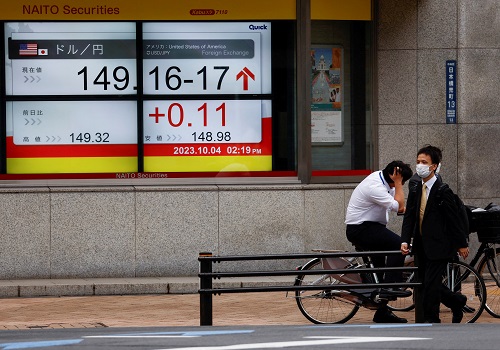Merchandise Trade - Risk of sticky deficit By Emkay Global Financial Services Ltd

Follow us Now on Telegram ! Get daily 10 - 12 important updates on Business, Finance and Investment. Join our Telegram Channel
Risk of sticky deficit
* Trade balance remains largely sticky and elevated in Dec’21 at USD22bn vs last month, despite better sequential gains in exports 24% MoM as compared to imports 12% MoM amid elevated commodity prices and improving domestic demand. Non-oil non-gold (NONG) imports continued to see healthy 34.2% YoY growth but rose marginally on a sequential basis. Exports and imports posted all-time highs in value terms.
* For YTD FY22, the trade deficit is high at USD140bn, higher than the pre-pandemic level of USD126bn for the same period in FY20. Imports’ buoyancy will likely continue to outperform exports ahead. Assuming oil at current levels, the trade deficit could moderate but hover close to highs of USD18bn+ ahead amid domestic demand and dragging global supply bottlenecks.
* We see CAD-to-GDP at 1.7% in FY22E and expect it to stay range-bound at 1.8%+ in FY23E. New global/domestic headwinds amid Omicron and persistent supply constraints would be the key things to watch out for. However, healthy capital flows will ensure that FY22E BoP remains in a surplus of USD41bn, which could moderate to USD30bn in FY23E. We see USD-INR hovering in the range of 74-76.50 in the near term. Factors like the LIC IPO and India’s inclusion in GBIs in the coming quarters could spur flows in mid-CY22 and may be a temporary boost to INR.
Slower import growth leads to sequential easing in trade deficit in Dec’21
As per the prelim estimates, the Dec’21 merchandise trade deficit was sticky at USD21.99bn vs. a record high deficit of USD23.3bn in Nov’21. Sequential higher export growth of 24.1% MoM cushioned 11.9% MoM growth in imports, leading to a mild 4% MoM fall in the deficit. On an annualized basis, exports grew 37% (27% in Nov’21), while imports grew 38% (down from 56.6% in Nov’21). Against Dec’19, exports and imports grew 37.6% and 49.7%, respectively, implying that India’s trade is comfortably above the prepandemic levels. For YTD FY22, exports and imports continued to clock strong growth of 49.8% (USD301.3bn) and 69.6% (USD441.5bn) YoY, respectively.
Exports pick up pace, engineering goods consistent performer
Exports surged 37% YoY to a record-high level of USD37.3bn in Dec’21, after clocking a nine-month low in the previous month. Sequentially, exports gathered pace by 24.1% MoM vs. a decline of 15.7% MoM in Nov’21. Oil exports were up 140% YoY at USD5.6bn vs. a seven-month low of USD3.8bn in Nov’21, momentum pick-up of 42% MoM vs. a decline of 26% MoM. Non-oil exports surged 27% YoY (18% in Nov’21) to USD31.7bn, reflecting decent global demand as exports recovered from the sequential decline of 14% MoM in Nov’21 to growth of 21.5% MoM in Dec’21. Growth in commodity groups, constituting ~62% of exports, was led by petroleum products (140%), engineering goods (37%), and organic chemicals (26%). Engineering goods, which contribute the most to exports (26%), have been consistently registering 35%+ growth during the last ten months. Meanwhile, pharma exports reverted to 3.8% YoY growth (25% MoM) in Dec’21, after three straight months of decline.
Record-high Imports but growth slows to ten-month low; NONG stays steady
As imports reached record levels of USD59.3bn in Dec’21, the import growth rate of 38% YoY (56.6% YoY in Nov’21) was the lowest in the last ten months (sequentially healthy at 12% vs. decline of 4.4% prior). Imports were higher by 49.7% above their pre-pandemic levels (Dec’19), signifying the extent of normalization. Oil imports surged 65% YoY with a healthy momentum of 8.3% MoM, driven by volume and price effects. Gold imports grew at the slowest rate in the last thirteen months (4.6%YoY in Dec’21), while sequential growth remained healthy at 11%. Electronic goods surged 30% YoY, gaining sharp sequential growth of 14% (-16% prior). NONG imports continued to grow at a healthy rate of 34.2% YoY (FYTD average ~49%, 12.9% MoM), led by electronic goods (30% YoY), machinery (23.2% YoY), organic chemicals (72% YoY) and Coal, Coke and Briquettes (72% YoY).
FY22 CAD-to-GDP at 1.7% amid normalization and oil effect; FY23 to be range-bound
Growth Q2FY22 onward seems to have normalized, led by global tailwinds and steady vaccination progress. New global/domestic headwinds amid Omicron and persistent supply constraints could, however, slow the cyclical global recovery. With import growth exceeding export growth and higher losses in oil-led terms of trade (and higher commodities in general), the FY22 CAD-to-GDP will likely track ~1.7% from the surplus of 0.9% in FY21. Though, healthy capital flows will ensure an FY22E BoP surplus of USD41bn (USD87.3bn FY21). Assuming oil at USD70/bbl in FY23E, the CAD-to-GDP could be rangebound at 1.8%+ of GDP, with the trade deficit widening to USD196bn (USD186bn in FY22E). While imports may remain steady, the upside pressure may fade as inventory rebuilding eases and the demand surge normalizes. Capital flows may just be able to offset the widening of CAD, led by the LIC IPO, bond index inclusion-related flows and healthy FDI pipeline. We see BoP surplus moderating to around USD30bn in FY23E. INR performance will be caught between mixed external terms of trade, gradually changing global risk environment and RBI’s FX stance. Factors like the LIC IPO and India’s inclusion in GBIs in the coming quarters could spur flows in mid-CY22 and may be a temporary boost to INR. We see USD-INR hovering in the range of 74-76.50 in the near term. This report is intended for team.emkay@whitemarquesolutions.com use and downloaded at 01/04/2022 12:43 PM This report is intended for team.
To Read Complete Report & Disclaimer Click Here
For More Emkay Global Financial Services Ltd Disclaimer http://www.emkayglobal.com/Uploads/disclaimer.pdf & SEBI Registration number is INH000000354
Above views are of the author and not of the website kindly read disclaimer





.jpg)




Tag News

Monthly Debt Market Update, September 2023: CareEdge Ratings













